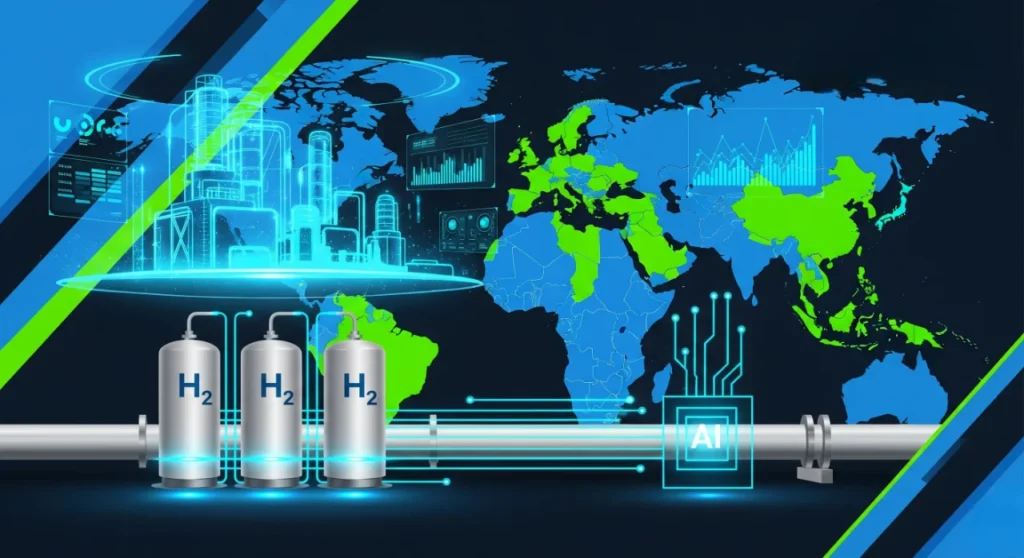The race to decarbonize energy just found a new accelerator: artificial intelligence.
Global demand for hydrogen is climbing, but its volatile nature and high costs remain obstacles. AI-powered solutions—ranging from predictive analytics to digital twins—are now being deployed to make hydrogen safer, cheaper, and more scalable. That shift could transform how industries power the next decade.
Key Takeaways
- Europe led AI in hydrogen operations with 37.1% share in 2024.
- Asia-Pacific expected to post the fastest CAGR through 2034.
- Machine learning & deep learning dominated 2024 with 28.5% share.
- Digital twin tech projected as fastest-growing segment ahead.
- Cloud-based deployments captured 44.7% of global share in 2024.
AI in hydrogen operations applies machine learning, digital twins, and predictive analytics to boost hydrogen production, storage, and transport. The technology improves safety, lowers costs, and enhances scalability—making hydrogen a more viable clean energy solution as industries worldwide aim for decarbonization by 2034.
Why It Matters Now
Hydrogen has long been touted as a cornerstone of the clean energy transition. But its volatile chemistry, storage hurdles, and costly production have slowed mass adoption. Enter artificial intelligence. From real-time electrolyser monitoring to predictive leak detection, AI is now at the center of hydrogen’s next growth wave.
Inside the Numbers
Europe currently dominates the market, accounting for 37.1% of global share in 2024, thanks to aggressive hydrogen policies and green energy incentives. Asia-Pacific, however, is tipped to grow fastest through 2034 as China, Japan, and South Korea double down on hydrogen for mobility and power.
By technology, machine learning and deep learning models held 28.5% of the 2024 market, while digital twin technologies—virtual replicas of hydrogen plants—are expected to grow the quickest. On the application side, hydrogen production optimization leads today, but hydrogen storage management is projected to accelerate as safety and efficiency become critical.
Industry Response
Tech players are moving fast. In April 2025, Honeywell introduced “Protonium,” an AI-driven suite designed to streamline green hydrogen production by cutting costs and improving scalability (Offshore Energy, 2025). Such announcements underscore how legacy industrial firms are pivoting to AI-powered hydrogen strategies.
The Bigger Picture
Hydrogen isn’t just about powering cars or replacing gas turbines. It’s also a geopolitical play. Nations investing in AI-enhanced hydrogen infrastructure aim to secure energy independence while meeting climate targets. With fossil fuel pressure mounting and the EU pushing for carbon neutrality by 2050, AI-hydrogen synergies are emerging as a strategic priority.
Safety and Reliability First
Hydrogen leaks and equipment failures can be catastrophic. AI-driven predictive maintenance has already shown it can cut costs by 20% in industrial trials. Hybrid models combining fluid dynamics and machine learning can now predict how leaks disperse—helping operators respond faster and with fewer risks.
Supply Chain Implications
Hydrogen’s value chain—from production to transport—is notoriously complex. AI models are being deployed to map out optimal logistics, schedule deliveries, and minimize delays. By analyzing geographical and economic data, AI can identify the safest and most efficient routes for hydrogen shipments.
What Happens Next
Looking ahead to 2034, experts see cloud-based AI deployments maintaining dominance, with 44.7% market share in 2024. Hybrid models are expected to gain ground, offering scalability without sacrificing security.
End-use industries tell the other half of the story: the energy and power sector captured 35.6% of market share last year, but transportation and mobility are projected to post the fastest CAGR—driven by fuel cell vehicles and hydrogen refueling infrastructure.
Conclusion
AI is no longer a futuristic add-on—it’s becoming the backbone of the hydrogen economy. As countries chase carbon neutrality, the convergence of AI and hydrogen operations could determine who leads the clean energy race by 2034.
